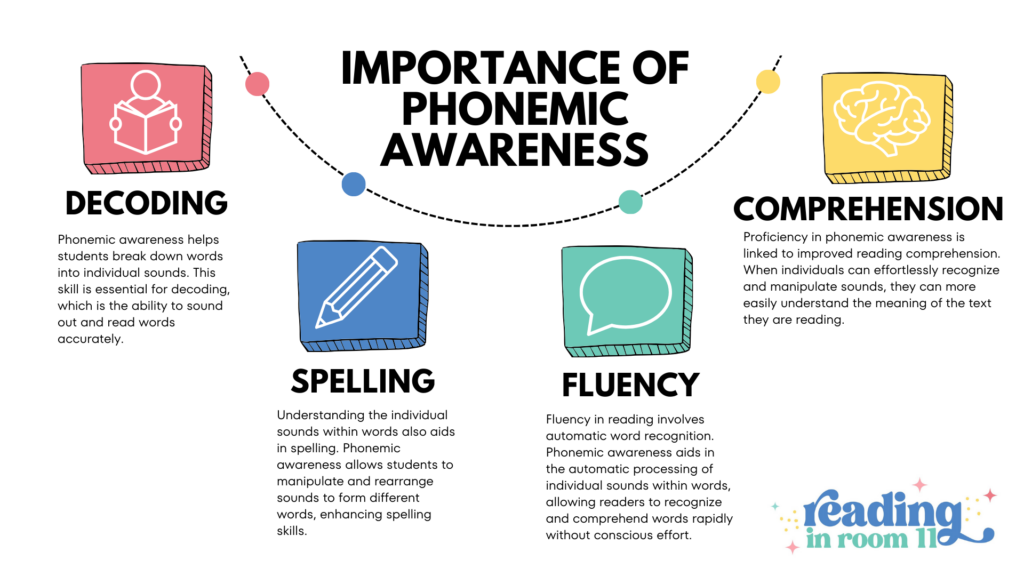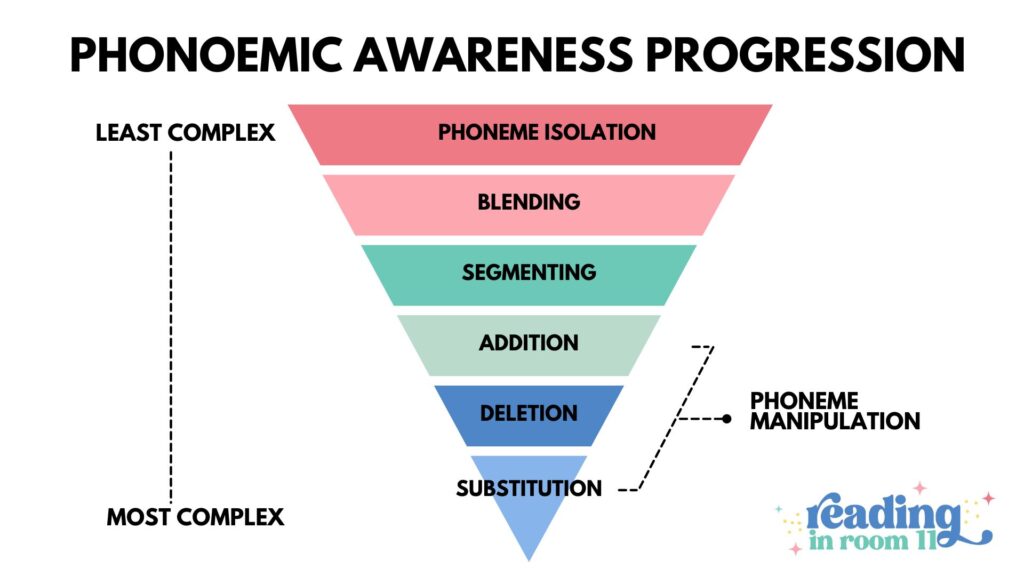Imagine trying to build a house without a strong foundation. It’s just like expecting students to be proficient readers without making sure they have solid phonemic awareness. It’s the basic building block for reading success! What is phonemic awareness exactly? It is knowing that words are made up of individual sounds and being able to play with and recognize those sounds in different words. It is also a critical skill for learning to read and spell.
In this blog post, we will explore the meaning of phonemic awareness, its importance, and examples from the phonemic awareness continuum.
What is phonemic awareness?
Simply put, phonemic awareness is knowing that words are made up of individual sounds and being able to play with and recognize those sounds in different words.
There is a six-step progression of phonemic awareness tasks starting with basic phoneme isolation and moving to complex phoneme substitution (more to come on that later).
Why is phonemic awareness important?
Phonemic awareness is critical to reading success. Without a strong foundation in phonemic awareness, students will struggle to become proficient readers. According to Dr. David Kilpatrick, the most common source of reading difficulties is poor phonemic awareness. The good news is that it is trainable.
Here are some of the impacts that phonemic awareness has on reading:
📘Word Decoding
Phonemic awareness helps students break down words into individual sounds. This skill is essential for decoding, which is the ability to sound out and read words accurately.
When students have weak phonemic awareness, they lack the ability to quickly and automatically read words.
✏️ Spelling
Understanding the individual sounds within words also aids in spelling. Phonemic awareness allows students to manipulate and rearrange sounds to form different words, enhancing spelling skills.
Students who have weak phonemic awareness will struggle with the task of isolating specific wounds in words leading to them adding or leaving off sounds when spelling.
🗣️ Fluency
Fluency in reading involves automatic word recognition. Phonemic awareness aids in the automatic processing of individual sounds within words, allowing readers to recognize and comprehend words rapidly without conscious effort.
Weak phonemic awareness leads to students having to stretch out sounds in words and word-by-word reading. This decreases student’s ability to read fluently.
🧠Reading Comprehension
Proficiency in phonemic awareness is linked to improved reading comprehension. When individuals can effortlessly recognize and manipulate sounds, they can more easily understand the meaning of the text they are reading.
When students lack strong phonemic awareness, they often focus on word-by-word reading making it difficult to think about what they are reading.

The most common source of reading difficulties is poor phonemic awareness. The good news is that it’s trainable.
Dr. David Kilpatrick | equipped for reading success
Examples of Phonemic Awareness
Earlier I mentioned the continuum or stages of phonemic awareness. Here is a breakdown of each element starting with the least complex and moving to the most complex.
It is important to note that these tasks do not involve print/letters, they are oral activities.
Within each task can be a varying degree of difficulty with word parts being the most basic and phonemes/sounds being the most complex.
Phoneme Isolation
Phoneme isolation is when students isolate a specific sound in a word. You may ask students to isolate the beginning, middle or ending sound of a word.
Example: What is the first sound in sun? /s/
Blending
Blending is when students take individual sounds and form a word.
Examples:
Word Parts: cup + cake = cupcake
Syllables: but + ter + fly = butterfly
Phonemes: /c/ /a/ /t/ = cat
Segmenting
Segmenting is the opposite of blending. Students take a word and break it down to individual sounds.
Examples:
Word Parts: cupcake = cup + cake
Syllables: butterfly = but + ter + fly
Phonemes: cat = /c/ /a/ /t/

These next three tasks involve manipulation:
Addition
Addition is when students add sounds to a word or word part.
Examples:
Word Parts: say cup, now add cake = cupcake
Syllables: butterfly = say pen, now add cil = pencil
Phonemes: say at, now add /c/ to the beginning = cat
Deletion
Deletion is when students take a sound away from a word or word part.
Examples:
Word Parts: say cupcake, now don’t say cup = cake
Syllables: say pencil, now don’t say pen = cil
Phonemes: say cat, now don’t say /c/ = at
Substitution
Substitution is the most complex phonemic awareness task. This is when students substitute or replace sounds (or word parts).
Examples:
Word Parts: say inside, now instead of in say out = outside
Syllables: say butter, now instead of ter say ton = button
Phonemes: say cat, now instead of /c/ say /b/ = bat
Final Thoughts
I hope that reading this post gave you a better understanding of what phonemic awareness is and why it is important. I love the house-building analogy that building a house without a strong foundation is like expecting reading proficiency without a strong base in phonemic awareness. Phonemic awareness is truly a crucial and foundational skill for reading.
In my next blog post, I will look at the different types of interventions when students are struggling or have gaps in their phonemic awareness.
Pin for Later:

